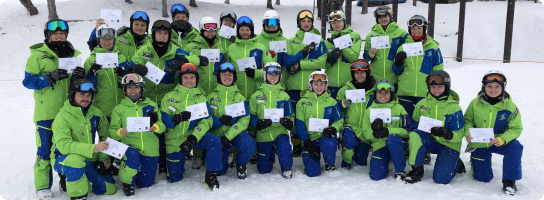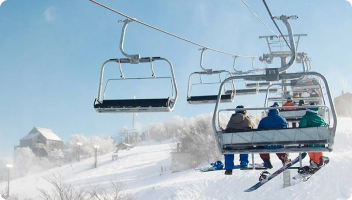Myoko Kogen Jobs & Working A Ski Season
Discover information on working a ski season in Myoko Kogen and browse winter jobs.
View jobs & employers
Myoko Kogen is one of the oldest and largest ski areas in Japan. Originally built in 1911, it is now made up of three main resorts/areas – Myoko Akakura, Myoko Suginohara and Ikenotaira Onsen. While Myoko is not as well-known internationally, secretly hosts some of Japan’s steepest and longest runs. The combination of low numbers of tourists, great terrain and plentiful snowfall make it a brilliant place to spend a holiday or a winter season.
In recent years it has grown a strong international reputation for it’s combination of great snow and great mountain terrain. Additionally, with a number of overseas-owned tour companies operating in the area, it has become an increasingly popular place to work a ski season, even if it isn’t as popular as the likes of Niseko, Hakuba or Furano.
Train & Work As A Ski/Snowboard Instructor
Spend a full winter training, qualifying and working as a ski/snowboard instructor in Japan or Canada. All-inclusive packages designed for people with no prior instructing experience.
Overview and Vibe
If you’re hoping to experience traditional Japan and its culture, but don’t want to go too far out of your comfort zone, Myoko is an excellent choice. While Myoke is not a glamorous or heavily “westernised” resort, it does have everything you’d need at an affordable price.
Myoko attracts a growing number of foreign tourists, and each season the amount of English-speaking workers is on the increase. There are several internationally-owned businesses operating in the region which contribute to this increase.
For most visiting Myoko the snow is the biggest draw card, and everything else such as the culture is a giant plus. Unlike some of the larger, more mainstream resorts, the powder takes longer to track out, and there is plenty to go at.
Myoko is located centrally on the main island of Honshu in an area of Japan called “snow country”, so it makes perfect sense that the area receives between 10-15 meters of snowfall each season.
Myoko is not a party town, but it still has a pretty good atmosphere off the snow. This includes a selection of nice restaurants, cosy izakayas and some lively bars which stay open fairly late.
Myoko’s status as an entirely unknown resort outside of Japan is slowly changing. These days, the area is welcoming a more diverse, international crowd, seeking great snow and an untarnished culture, though the masses have not arrived in the same way as Niseko or Hakuba.
Location and Getting There
Myoko is 270km northwest of Tokyo and there are several different ways to get to the Myoko ski resorts.
Train – The city of Nagano is around one hour south of Myoko, and a major terminal for Japan Railways and the infamous bullet trains. From Nagano, you are able to take a local train or bus directly to Myoko Kogen. If arriving by airport (Narita or Haneda), you will need to go to Tokyo station to get on the correct train to Nagano. In total, expect to take 3.5-4 hours to arrive at the resort from the airport. Travelling by train is a great way to see Japanese countryside and culture at the same time.
Bus – Through winter there are bus transfers direct from the airport to Myoko resorts which can be booked. They run several times a day from Narita and Haneda, and are operated by a company called Nagano Snow Shuttles. This does take slightly longer than the train or driving, but it is a stress-free option. It is best to contact them directly for information or to book a ticket.
Drive – With an international driving permit you are able to hire cars in Japan. From Tokyo, it will take 4 to 5 hours. From Nagano, it will be around one hour depending on conditions. It is easiest to rent from Nagano where there are several hire companies located.
Getting around Myoko Resorts
Myoko Kogen is made up of a few different resorts, the main areas being Akakura Onsen and Akakura Kanko (Akakan aka Shin-Akakura) which are connected by a free resort shuttle bus service.
The other resorts of Ikenotaira, Seki Onsen and Suginohara are also accessible by a bus service, but these services are less frequent and should be planned and booked ahead of time.
Terrain
Across the collection of Myoko resorts, there is some really great terrain, though nothing in the way of massive steeps. For beginners, it is easy to find gentle, wide slopes. Intermediate and advanced riders can enjoy the longer runs with some great tree skiing too. More advanced riders will be able to escape the named trails to find great off-piste and backcountry terrain.
Below is a quick rundown of each area:
- Myoko Akakura – This is the interconnected areas of Akakura Onsen and Akakura Kanko. These ski resorts are fairly large for Japan, and close to the majority of accommodation. There is a small terrain park, tree-skiing and some good off-piste areas. Night skiing is also available, but it is more geared towards beginner skiers or snowboarders.
- Seki Onsen – This is a powder-chasers resort, which draws lots of visitors when the snow is good and especially at the weekend with locals. While the resort only has two lifts, providing access to around 300m of vertical, it has a good amount of terrain and will usually take several hours to track out.
- Suginohara – Famed for having one of Japan’s longest trails, this resort is built for cruising – and probably best to visit when conditions aren’t so good elsewhere. This resort also has the area’s best terrain park and in recent seasons has improved in size and quality. There are also great off-piste areas here which are away from crowds.
- Ikenotaira Onsen – This is a fairly small resort well suited to beginners, children and those looking to develop their powder and tree skiing.
- Madarao / Tangram Circus – While these resorts do not officially form part of the Myoko ski area, they are a short shuttle bus away and popular as alternatives to skiing the Myoko resorts. Madarao also has a traditional but small resort town with some shops, bars and, of course, great snow conditions.
In total, there are around 20 lifts giving access to over 50 ski runs of varying difficulty and length. There is also the opportunity to purchase a “Myoko Big 4” Pass. However, this is only cost effective for season passes.
Snow and Season at Myoko
The Myoko region is famed for large snowfalls, often receiving over 14 metres each year! Snow quality is not quite as dry/light as in Hokkaido, but it’s still some of the best in the world.
The snow season usually starts in mid-December, but sometimes it can be slow to start due to snow coverage. Resorts stay open until late April or early May. As with most of Japan, January and February are the peak months for tourism and snowfall.
How to Find a Job
You can find most of our information on getting a job in Japanese ski resorts on our main Japan page, with points specific to Myoko below.
The main seasonal work opportunities in the Myoko area are for ski instructors, snowboard instructors, hotel workers, bar staff, rental shop workers and restaurant staff.
While the resort is not so busy, there should be plenty of work for instructors and less competition for jobs generally.
Most of the resort focused jobs, such as lifties, mountain operations, patrol, grooming, or terrain park crew will go to the local Japanese in the area.
Myoko Snowsports is an established Australian-owned ski school which also provides accommodation, rental and other tourist services. This is one of the largest employers in the area and is a good starting point. https://myokosnowsports.com/employment/
ActiveLife Madarao is also an established business aimed at an international audience. They have a large number of jobs for winter workers. More information on jobs can be found at https://beactive.life/jobs/. They will have a range of positions including ski/snowboard instructors, hospitality, kitchen work and other positions.
As with many ski resorts, joining the local Facebook group is a great way to find out about opportunities first and talk directly to hiring staff. https://www.facebook.com/groups/Myokotrade
Note, most people working a season in Myoko will be on the working holiday visa program, except instructors who might use a sponsored visa. Our main Japan page has more info on visas.
Finding Accommodation
If you are able to find a job with one of the major companies, they will be able to assist finding accommodation. It can be very difficult to find accommodation in Japan. Finding a job with accommodation included is a good option, for this reason.
Most accommodation will be found around the Akakura Onsen Ski Area, and there are several hostels in town which could be good options for longer stays if working. However, this can be expensive in peak season, so trying to find apartment accommodation is usually best.
The Facebook group is also a good place to start asking questions, as people often have spare rooms available here – https://www.facebook.com/groups/Myokotrade.
Nightlife and Outside Work
Myoko might not have pumping bars like Hakuba and Niseko, but this means there is a general peace over the city and more of a chilled vibe. Nonetheless, there are still over 50 different types of bars and restaurants to choose from, so no shortage of places to explore.
Some of our favourite places to eat include:
- Akatako – A local-run izakaya with a really cosy atmosphere and great food.
- Pomodoro – An established Italian restaurant with great pizza and pasta options.
- Gelato Okura – As the name suggests, a nice dessert stop on the way home!
- Panorama Cafe – A fusion of Japanese and International cuisine.
Some of the best drinking holes are:
- Skate Bar – This bar has a skate ramp in it and is popular with tourists and seasonal workers. It stays open late and serves a great range of drinks.
- Popcorn – a cosy bar with decent music and a pool table. There is also popcorn!
- Hunter – A lively karaoke bar which has a good selection of Western songs.
- Love Bar, a.k.a. Shot Bar Love – The only club in Myoko which holds numerous events with DJs throughout the season.
For ski/snowboard equipment there are various rental shops across the resorts, and most of them do sell some equipment too. However, the choice can be limited, so you’d be better off purchasing what you need before you arrive either overseas or in Tokyo.



